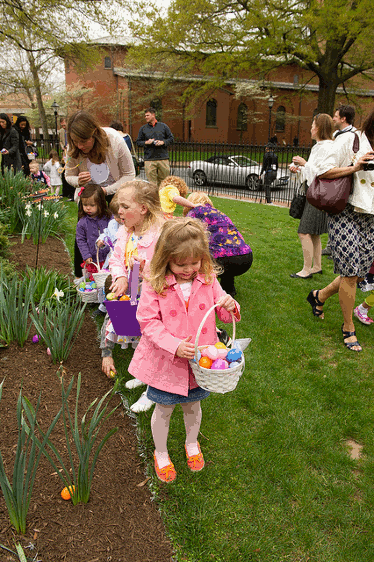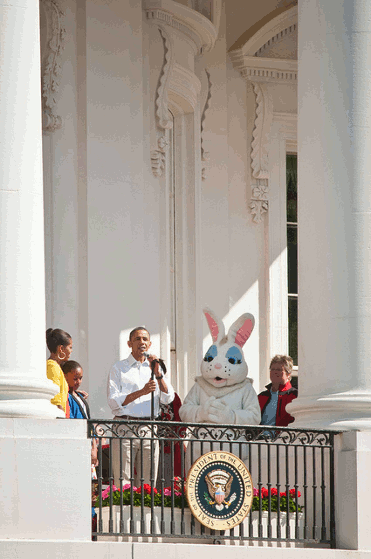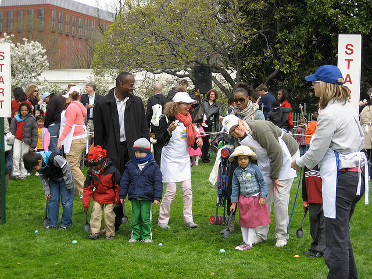In
various traditions the egg continues to
maintain a pivotal
role during the whole period of the Easter festivity. During
the fasting
period of Lent, eggs are often not eaten and therefore accumulate
until Lent ends at Easter.
The exchange of chocolate Easter eggs is also a very popular custom in
a wide number
of countries. Multicolored Easter eggs are coveted prizes
in numerous children's games including hunting eggs
whereby children look for hidden eggs.
 Easter Egg Hunt at Maryland
Government House
Easter Egg Hunt at Maryland
Government House
Photo
by Jay baker, courtesy of MDGovpics
In the Balkan and Greek
orthodox
tradition hard boiled eggs have for centuries been
traditionally coloured of red, the symbol of the Passion.
More
recently various different colours are used for
decoration, generally during Maundy Thursday which
commemmorates the
Last
Supper, and are eaten at Easter and in the following days. On
Easter
day, in many rituals, eggs are publicly blessed as the symbol of
resurrection and of the cycle of life. They are
subsequently
given to onlookers.
In
Greece, Holland and a
number of other countries, particularly at the Easter meal
table
before the eggs are eaten, a game is played where everyone
chooses
their own egg and a competition (known as tsougrisma in Greece
which means "to clink together") is held where competitors tap the tips
of their eggs together with another player. The winning egg is the one
that doesn't crack, and this one is considered to bring good luck.
These days colours are made using typical food
colouring, but
in past
vegetables were used, including the outer peels of red onions.
In
Belgium and France, the church bells do not ring between Good
Friday
and Easter Sunday. Legend tells that the bells
fly to Rome where they stay until Easter and, on their return
they drop
eggs,
which children must find. Belgian children make
straw nests which they
hide in the grass, leaving them to be filled with eggs by
the Easter
Bunny .
 President Barack Obama and
the Easter Bunny at the Whitehouse Easter Egg Roll in 2012
President Barack Obama and
the Easter Bunny at the Whitehouse Easter Egg Roll in 2012
Picture
by Bob Nichols, courtesy of USDAgovBulgarians
color eggs which are cooked after Mass on Maundy Thursday.
Passover
breads also are a very strong tradition: they can be big or
small, but
are always decorated. The bread is called "kolache" or "kozunak". It
tastes similar to a Brazilian pannetone sweetbread. Some of these
breads are specially decorated with red eggs (always in
odd numbers) and taken to the church on the Saturday morning
for a
sequence of liturgies. After these events, the breads and eggs are
blessed
and taken back home. These foods are then given to Turkish friends
of the family, parents, godfathers and godmothers, and all the other
relatives and friends. The eggs are broken after the
midnight mass and during the subsequent days. One of the eggs is broken
on
the wall of the church. This is the first
egg to be eaten after
the fast of Lent. Another ritual, happens
after the Easter lunch. Instead of eggs
being hidden, they battle each
other in an
egg fight. These are true
high-pitched contests. Everyone in a family will hold an egg, and pair
up with an opponent. The eggs are tapped together and it is
said that
the one whose egg stays unbroken until the end will have a
year of good
luck.
The
most common activity for this holiday in the United States is
the
Easter Egg hunt. Boiled eggs are decorated with paint
and hidden for
children to find. In smaller communities, the town's children
meet in
squares to find the eggs hidden everywhere. At the White House, the
seat of government for the USA, people from the whole country
congregate. The tradition comes from the
beginning of the 1870s, when children played,
during Easter, on the lawn of the Washington DC Capitol. They
took
boiled eggs
and rolled them in the grass to see who managed to get their
egg the
farthest. In 1877, a law prohibited
the activity, but president Rutherford Hayes, in 1878, released the
south lawn of the White House for egg rolling. Today, tickets
are
issued free for children between 3 and 6 years
old, accompanied by
their parents, who participate for
several fun activities around the White House before it is
time for
them to roll eggs on
the lawn.
The
Swedes maintain a very solemn Holy Week. To perform wedding
ceremonies
and baptisms at this time is considered inappropriate.
However,
the picture is gradually changing. In recent
years cinemas in Sweden have opened
on Good Friday. Due to the climate of the
country, the palms of Palm Sunday are usually substituted by
willow branches. Because of being connected with this liturgy, the
willow leaf became known as "a palm" by the Swedes. The Easter
traditions of Sweden and
of other Scandinavian countries are very reminiscent of the USA's
Halloween. On Holy Thursday or on the eve of Easter, Swedish
children dress as wizards and visit their neighbors, leaving
a
decorated card (the "Easter Letter") and wait to
receive sweets
or money in exchange. This custom originates from a local
legend, where
it was said that during Easter, the activity of witches and
wizards significantly increases. The tradition of the
"letters" is
especially widespread in the west of Sweden, where also it is customary
to put
these letters in mail boxes or under doors without
being seen.
The identity of who sent the card is always secret.
Swedish people
also deliver boiled eggs during Easter, this
tradition is not as
prevailant as in other European countries.
In
the Middle East, crimson eggs are exchanged to remember
Christ's
blood that he shed on the cross. The Armenians empty them
and decorate them with images of Christ and the Virgin Mary.
In
Poland and the Ukraine real works of art are created
with melted wax on the shells of eggs.
A
form of ground tax in Gemany, known as Zinsei operated in the
Middle Ages, whereby in Spring farmers would need to pay
taxes to
their landlords on Maundy Thursday.
During Lent it was
forbidden in those days to eat hens' eggs, as they were
considered to
be a form of meat. By the end of Lent when the Zinsei
taxes
were due, the farmers therefore had a surplus of eggs and used eggs to
actually pay the Zinsei taxes.
In
Alsace,
Germany,
Switzerland
and in most states of Austria, the Easter eggs are brought by the
Easter Bunny (Osterhase).
There are no bells, very few chicks but many rabbits in
all possible
and conceivable forms. Here one of the origins of this legend: tells of
an
old woman, without money to buy eggs for her small children, who
decided
to paint some. She hid them in her garden, and called the
children, inviting them to seek their surprise gifts.
Suddenly, a
rabbit
jumped out from a small nest of brushwood where the
eggs
were. A child shouted, filled with wonder: “The rabbit left
eggs
painted for our Easter surprise!”.
 The start of the Easter Egg
Roll competition at America's Whitehouse
The start of the Easter Egg
Roll competition at America's Whitehouse
Photo
by creativedcIn
fact, the rabbit,
very prolific in spring,
is probably a symbol of fruitfulness, originating before Christianity.
It should
be noted that in Bavaria
and in the Tyrol, the hare is replaced by a hen; in Westphalia and
Thuringe
it is a fox; and in Hanover
it is a cuckoo. This tradition of a rabbit bringing Easter eggs
travelled to Brazil
where it is still celebrated.
In
order to bring luck
to a house in the South Tyrol in Austria, the custom
exists of throwing an egg over the house and then burying it.
In
many other countries, chicken eggs are still preferred to
chocolate eggs. These are usually hard boiled. Also in the
countries where
orthodox religion prevails, the tradition of chicken eggs remains, in
response to the spread of mass produced chocolate
eggs,
considered by some orthodox Christians to be a
commercialisation of Easter.
In Italy the boiled egg symbol has remained popular,
usually accompanied by the traditional Easter dove or
served
during dinner. The Easter egg also
represents Jesus'
resurrection in many Arabian countries.
In
the 19th century Finnish
National Epic poem, Kalevala, the
world was born from the fragments of an egg .
The lower half of the egg became the earth and the
upper part
became the sky. The sun was created from the yolk
and the moon was
made from the white of the egg. "All the coloured bits"
became stars,
and "darker crumbs" became clouds in the sky.
Since the
12th century the Polish tradition of Swieconka
has been celebrated on the Saturday between Good Friday and
Easter Sunday.
Baskets containing Easter foods are blessed at Church. Eggs
are
included amongst the food in the baskets, as they are deemed to be a
wholesome food for God's faithful sevants who take them
in gratitude and in memory of the life and
resurrection of Christ.
The
world largest Easter egg is in Betzdorf in Germany. It stands
9.27 metres high with a diameter of 5.71 metres.

|
|